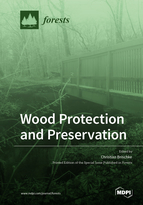Wood Protection and Preservation
A special issue of Forests (ISSN 1999-4907). This special issue belongs to the section "Wood Science and Forest Products".
Deadline for manuscript submissions: closed (30 November 2019) | Viewed by 59473
Special Issue Editor
Interests: wood quality; wood durability; wood modification; wood protection; service life prediction; structural health assessment; performance classification
Special Issues, Collections and Topics in MDPI journals
Special Issue Information
Dear Colleagues,
Globally, the use of non-renewable resources needs to be reduced. In this respect, wood and wood-based products can play a key role as they are generally low in embodied CO2 and can be gained from sustainable forest resources. Wood has numerous advantages compared to other building materials, such as a high strength–weight ratio, good thermal insulation, easy machinability, and appealing aesthetics. However, its durability against different biological agents is limited and requires consideration when wood is exposed to moisture, and thus to favorable conditions for decay.
In highly hazardous applications, the natural durability of wood can be insufficient, and wooden elements need to be protected by design. Alternatively, wood durability can be enhanced through wood preservatives or modification systems. During recent years, several highly effective wood preservatives have been banned in different countries, as they harm human health and the environment. Innovative approaches for improving wood durability are being sought.
We encourage studies from all fields, including method development, experimental studies, monitoring approaches, and models, to contribute to this Special Issue, in order to promote knowledge about wood durability mechanisms and strategies for the protection and preservation of wooden structures and wood-based building materials.
PD Dr. Christian Brischke
Guest Editor
Manuscript Submission Information
Manuscripts should be submitted online at www.mdpi.com by registering and logging in to this website. Once you are registered, click here to go to the submission form. Manuscripts can be submitted until the deadline. All submissions that pass pre-check are peer-reviewed. Accepted papers will be published continuously in the journal (as soon as accepted) and will be listed together on the special issue website. Research articles, review articles as well as short communications are invited. For planned papers, a title and short abstract (about 100 words) can be sent to the Editorial Office for announcement on this website.
Submitted manuscripts should not have been published previously, nor be under consideration for publication elsewhere (except conference proceedings papers). All manuscripts are thoroughly refereed through a single-blind peer-review process. A guide for authors and other relevant information for submission of manuscripts is available on the Instructions for Authors page. Forests is an international peer-reviewed open access monthly journal published by MDPI.
Please visit the Instructions for Authors page before submitting a manuscript. The Article Processing Charge (APC) for publication in this open access journal is 2600 CHF (Swiss Francs). Submitted papers should be well formatted and use good English. Authors may use MDPI's English editing service prior to publication or during author revisions.
Keywords
- Biological durability
- Decay Fungi
- Wood borers
- Wood protection by design
- Wood preservatives
- Chemical wood modification
- Thermal wood modification
- Water repellants
- Test methods
- Service life planning
- Performance specification






